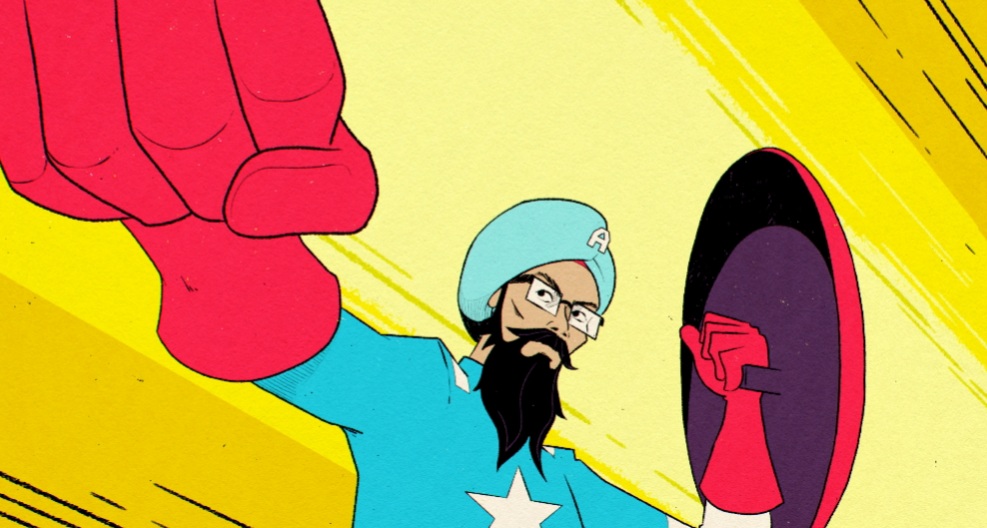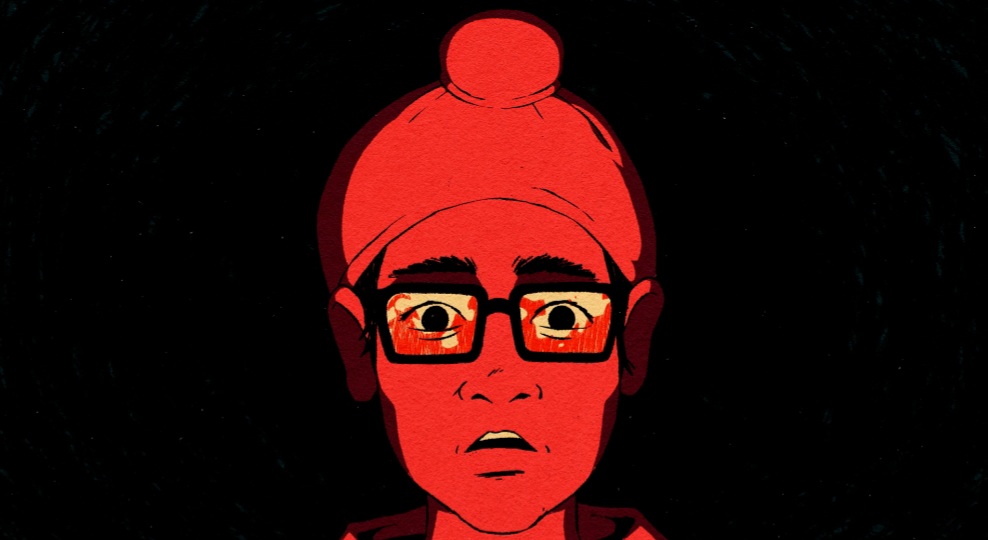If you and your ancestors have been here a long time, it’s very easy to take being an American for granted. We are often reminded, though. Some of us see the newest among us and envision with pride the opportunity America gave our grandparents. But others aren’t so kind and forget they were once the marginalized outsider. Then throw in whatever the current anti-immigrant mania is, and America can be a dangerous place. Vishavjit Singh can tell you first hand, and in his short film American Sikh, he does so in hopes of engendering the better angels of America’s psyche.

The Singh/Ryan Westra animated short doesn’t wait to get started either. Out of the black, the rims of Singh’s rectangular glasses appear and against the background of his fearful pupils, the image is engulfed in flames.
The main character then closes his eyes in sorrow and the voice-over clues us in. When he was 12 years old, Indira Gandhi was assassinated by two of her body guards. Both wore turbans and whether or not they were Sikh, it was open season on followers of the religion. “Our turbans became targets,” he said in a delivery that is profound.
Singh strips the emotion away, and as result, the words and images stick out all the more powerfully. The score does a number too. Haunting, the music feels like it is hollowing out an abyss, and Singh is teetering on the edge.

Still, the character’s story actually begins in America. His father an embassy worker, Singh was born in Washington DC, and the first American citizen in the family. The memories were happy, and the old 8mm footage reinforces the point.
In comparison to the animation, the footage comes off more like a fairytale, and we will soon see why. Nonetheless, his parents missed their Sikh community and the return to India is signaled by the switch back to animation.
The young boy was hooked, though. He continued to immerse himself in American culture, and dreamed of returning.
Superman, Michael Jackson and Star Wars, his story is a familiar one. Unfortunately, real life played out in 1984. Thousands of Sikhs were then killed in riots, and the mass hysteria had Singh isolated for the first time. “No part of me felt Indian anymore,” he said.

The horror aside, the teenager didn’t discontinue his desire to come back to America, and at 18, he emigrated. No shock, his memories and the idealized version of the United States didn’t live up to the reality.
With his turban, facial hair and dark skin, the teenager was not given such a warm welcome. He literally became a man without a country. Trying to fit in, Singh went through a variety of identities. He frequently changed his dress, presentation and religious philosophy to make America a home he could live in.
A spiritual awakening does eventually give him some sturdy grounding but then 9/11 happens. The threat of violence again becomes a very real thing, and the colorful animation gives way to the spectrum that began the film.

Black and white implies the all or nothing thinking of irrational fear, and the consequences are then laid out on the background canvas that the framing creates. Blood red splatter intensifies the images of violence, and Singh gets even closer to the edge.
So the American does something drastic. Almost comic book in nature, he appeals to this country where it lives. The popular culture unites us like no other thing, and Singh employs the American fact of life to make his point.
You don’t know whether to laugh at the comic absurdity or lament the dichotomy that is America. In one respect we have a creative, welcoming spirit that inspires the world over. And in the other, groupthink can reduce whole peoples and ideas to the sum of our worst fears.
In this, American Sikh doesn’t just seek common cause for the disenfranchised. All of us should stand up, and do what we are already so good at. Be welcoming and accepting, America will be better for it. . . and so will you.

